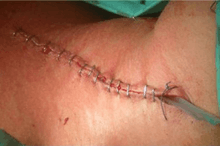Drain (surgery)
A surgical drain is a tube used to remove pus, blood or other fluids from a wound.[1] They are commonly placed by surgeons or interventional radiologists.
.jpg)

Use
The routine use of drains for surgical procedures is diminishing as better radiological investigation and confidence in surgical technique have reduced their necessity. It is felt now that drains may hinder recovery by acting as an 'anchor' limiting mobility post surgery and the drain itself may allow infection into the wound. In certain situations their use is unavoidable.
Drains may be hooked to wall suction, a portable suction device, or they may be left to drain naturally. Accurate recording of the volume of drainage as well as the contents is vital to ensure proper healing and monitor for excessive bleeding. Depending on the amount of drainage, a patient may have the drain in place one day to weeks. Drains will have protective dressings that will need to be changed daily/as needed.
Complications
Drains have a tendency to become occluded or clogged, resulting in retained fluid that can contribute to infection or other complications. Thus efforts must be made to maintain and assess patency when they are in use. Once a drain becomes clogged or occluded, it is usually removed, as it is no longer providing any benefit.
Types of drains
Surgical drains can be broadly classified into:
- Jackson-Pratt drain - consists of a perforated round or flat tube connected to a negative pressure collection device. The collection device is typically a bulb with a drainage port which can be opened to remove fluid or air. After compressing the bulb to remove fluid or air, negative pressure is created as the bulb returns to its normal shape.
- Blake drain - a round silicone tube with channels that carry fluid to a negative pressure collection device. Drainage is thought to be achieved by capillary action, allowing fluid to travel through the open grooves into a closed cross section, which contains the fluid and allows it to be suctioned through the tube.[2]
- Penrose drain - a soft rubber tube
- Negative pressure wound therapy - Involves the use of enclosed foam and a suction device attached; this is one of the newer types of wound healing/drain devices which promotes faster tissue granulation, often used for large surgical/trauma/non-healing wounds.
- Redivac drain - a high negative pressure drain. Suction is applied through the drain to generate a vacuum and draw fluids into a bottle.
- Pigtail drain - has an exterior screw to release the internal "pigtail" before it can be removed
- Davol
- Chest tube - is a flexible plastic tube that is inserted through the chest wall and into the pleural space or mediastinum
- Wound manager
References
- Jain, Sudhir Kumar; Stoker, David L.; Tanwar, Raman (2013-04-30). Basic Surgical Skills and Techniques. JP Medical Ltd. pp. 70–73. ISBN 9789350903759. Retrieved 2014-09-07.
- Obney, James; Mary Barnes; et al. (2000). "A method for mediastinal drainage after cardiac procedures using small silastic drains". The Annals of Thoracic Surgery. 70 (3): 1109–110. doi:10.1016/s0003-4975(00)01800-2.
External links
